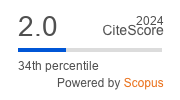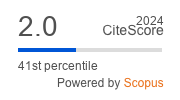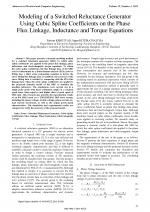| 1/2015 - 6 |
Modeling of a Switched Reluctance Generator Using Cubic Spline Coefficients on the Phase Flux Linkage, Inductance and Torque EquationsKERDTUAD, P. |
| Extra paper information in |
| Click to see author's profile in |
| Download PDF |
Author keywords
switched reluctance generator, cubic spline coefficients, flux linkage, phase inductance, electromagnetic torque
References keywords
reluctance(25), switched(23), power(8), motors(8), motor(7), electronics(7), conversion(7), modeling(6), model(6), magnetics(6)
Blue keywords are present in both the references section and the paper title.
About this article
Date of Publication: 2015-02-28
Volume 15, Issue 1, Year 2015, On page(s): 41 - 48
ISSN: 1582-7445, e-ISSN: 1844-7600
Digital Object Identifier: 10.4316/AECE.2015.01006
Web of Science Accession Number: 000352158600006
SCOPUS ID: 84924809565
Abstract
This paper presents a dynamic modeling method for a switched reluctance generator (SRG) by which cubic spline coefficients are applied to the phase flux linkage, phase inductance and electromagnetic torque equations. To obtain the cubic spline coefficients, the flux linkage data of the SRG are first determined by a finite element analysis (FEA) prior to fitting into a third order polynomial equation to derive the curve fitting flux linkage data. In addition, the accuracy of the curve fitting data is verified by comparing with the FEA flux linkage data. Then, the cubic spline coefficients are applied to the proposed dynamic model of the SRG to simulate the machine behaviors. The simulations were carried out in a single pulse mode with fixed conduction angles at a rotation speed lower than, equal to and higher than a based speed of 6000 rpm. This research also presents the experimental results of an 8/6 SRG based on a TMS320F2812 DSP drive system, including the phase voltage, dc-link voltage, phase current, dc-load current waveforms, as well as the output power-speed characteristics. The simulation and experimental results are compared to verify the accuracy of the proposed model. |
| References | | | Cited By |
Web of Science® Times Cited: 6 [View]
View record in Web of Science® [View]
View Related Records® [View]
Updated 2 weeks, 6 days ago
SCOPUS® Times Cited: 6
View record in SCOPUS® [Free preview]
View citations in SCOPUS® [Free preview]
[1] Peak Points Detection Using Spline Interpolation Based on FPGA Implementation, COLAK, A. M., MANABE, T., KAMASAKA, R., SHIBATA, Y., KUROKAWA, F., Advances in Electrical and Computer Engineering, ISSN 1582-7445, Issue 4, Volume 19, 2019.
Digital Object Identifier: 10.4316/AECE.2019.04001 [CrossRef] [Full text]
[2] A Semi-Analytical Method for Obtaining the Flux-Linkage Characteristics of Mutually-Coupled Switched Reluctance Machine, Guo, Xiaoqiang, Lyv, Tu, Zhong, Rui, Hua, Wei, Wen, Xiaogang, IEEE Transactions on Industry Applications, ISSN 0093-9994, Issue 2, Volume 60, 2024.
Digital Object Identifier: 10.1109/TIA.2023.3336295 [CrossRef]
[3] FEM analysis and design of an electromechanical converter with dual stator windings and flexible wave rotor, Ungureanu, Constantin, Irimia, Daniela, Bobric, Elena Crenguta, 2016 International Conference on Development and Application Systems (DAS), ISBN 978-1-5090-1993-9, 2016.
Digital Object Identifier: 10.1109/DAAS.2016.7492546 [CrossRef]
Disclaimer: All information displayed above was retrieved by using remote connections to respective databases. For the best user experience, we update all data by using background processes, and use caches in order to reduce the load on the servers we retrieve the information from. As we have no control on the availability of the database servers and sometimes the Internet connectivity may be affected, we do not guarantee the information is correct or complete. For the most accurate data, please always consult the database sites directly. Some external links require authentication or an institutional subscription.
Web of Science® is a registered trademark of Clarivate Analytics, Scopus® is a registered trademark of Elsevier B.V., other product names, company names, brand names, trademarks and logos are the property of their respective owners.
Faculty of Electrical Engineering and Computer Science
Stefan cel Mare University of Suceava, Romania
All rights reserved: Advances in Electrical and Computer Engineering is a registered trademark of the Stefan cel Mare University of Suceava. No part of this publication may be reproduced, stored in a retrieval system, photocopied, recorded or archived, without the written permission from the Editor. When authors submit their papers for publication, they agree that the copyright for their article be transferred to the Faculty of Electrical Engineering and Computer Science, Stefan cel Mare University of Suceava, Romania, if and only if the articles are accepted for publication. The copyright covers the exclusive rights to reproduce and distribute the article, including reprints and translations.
Permission for other use: The copyright owner's consent does not extend to copying for general distribution, for promotion, for creating new works, or for resale. Specific written permission must be obtained from the Editor for such copying. Direct linking to files hosted on this website is strictly prohibited.
Disclaimer: Whilst every effort is made by the publishers and editorial board to see that no inaccurate or misleading data, opinions or statements appear in this journal, they wish to make it clear that all information and opinions formulated in the articles, as well as linguistic accuracy, are the sole responsibility of the author.



